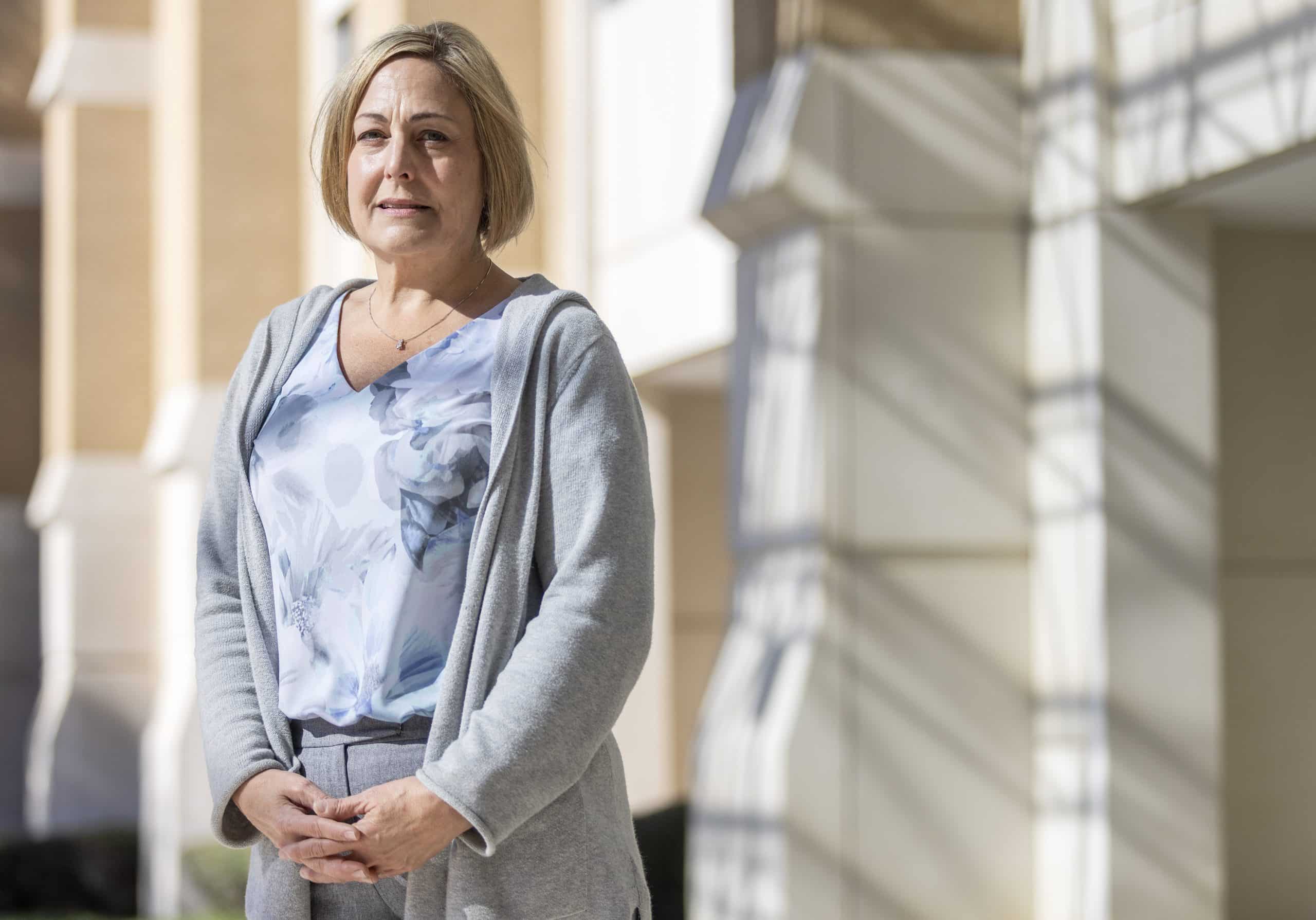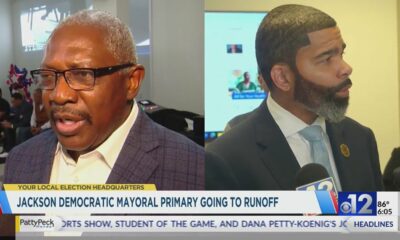Mississippi Today
Q&A with midwife Janice Scaggs

When Janice Scaggs joined the University of Mississippi Medical Center in 2020, she became part of a growing effort by the state’s largest public hospital and academic medical center to reintroduce midwifery into Mississippi’s maternal health care.
Certified nurse-midwives like Scaggs are educated in graduate-level midwifery programs and also hold an active registered nurse credential at the time of certification.
In the last three years, Scaggs, as the hospital’s only midwife, attended a little over six percent of births at UMMC each year.
In June, a second certified nurse midwife, Kim Rickard, joined the team. As part of the nurse midwifery clinical advisory committee, she and Scaggs plan to integrate a minimum of eight new nurse midwives into UMMC hospitals and clinics to offer round-the-clock midwifery care by 2027.
Midwives advocate for autonomy and comfort over efficiency for their patients, and have been proven to decrease unnecessary interventions such as cesareans in low-risk mothers – thereby improving morbidity and mortality, as well as postpartum mental health, and lowering the overall cost per capita of care.
Doctors and OB-GYNs are experts when it comes to abnormal pregnancies, Scaggs explained, but they don’t always know how to stand back and let a normal physiological birth unfold.
“Midwives … are the experts in normal, and have always been educated on a patient-centered model of care, really advocating for the patient and family, and empowering them,” she said.
Unnecessary cesareans and their increased use in Black pregnancies are not only a large contributor of preventable maternal deaths, but also a large contributor of maternal health disparities. Maternal mortality and morbidity after emergency cesarean birth is nearly 5 times than after vaginal birth.
Midwives are proponents of simple, but successful, low-intervention practices during labor – such as mobility and intermittent auscultation, or a technique of listening to and counting fetal heartbeats for a short period of time during active labor.
Editor’s note: This interview has been edited for clarity and length.
Mississippi Today: The term “midwife” translates to “with woman.” How do you see your role as a midwife, and how does it differ from that of, say, a doctor?
Janice Scaggs: We have so many similarities that sometimes that’s a really difficult question, but then on the other hand it’s really not.
If you look at the midwifery-led model of care, it really focuses on the individual, on putting them at the center of care, midwives being advocates for their patients and families – they want to empower the woman.
We focus on normal and healthy, certainly recognizing the abnormal. I look at us as the experts of that normal (births), whether it’s OB care, birthing, or gynecologic care, as well as family planning. I would say that that differs from our physician colleagues, because they really are focused on what the abnormal is, and they are experts when things are not going right.
MT: Tell me about the evidence around midwife-led care in reducing maternal and neonatal morbidity and mortality.
Scaggs: It’s well documented in other countries where midwifery is integrated into the health care system that it improves outcomes. We now have some good evidence in the U.S. to look at those evidence-based benefits, as well, including decreasing unnecessary interventions, improving the overall outcome of health – mental health as well as physical health – and decreasing the cost of health care, as well.
We increase breastfeeding rates, decrease preterm birth rates, and then (use) that approach of not using intervention unless absolutely necessary. We end up not performing interventions that can lead to morbidity, when maybe they didn’t need to be done, such as an unnecessary primary cesarean section.
MT: So, in today’s world, more women give birth in hospitals, and around technology, than ever before. But that hasn’t necessarily led to better outcomes. We know that because of infant and maternal mortality rates, and also high cesarean rates – across the country but particularly in Mississippi. Tell me about your non-pharmacological approach to birth and your philosophy around that.
Scaggs: I look at non-pharmacologic support as being an option that can either be done on its own or can be integrated with medical technology and pharmacologic options for women, as well. So they don’t have to stand separated.
But if we’re focusing on non-pharmacologic, we know from research that mobility, upright positions in the first stage of labor, decreases the length of labor, it decreases other interventions, it decreases cesarean rate. It improves comfort for moms who are trying to cope with labor without pharmacologic methods.
So, giving women permission and opportunity to move in labor – they will and they want to. If we put them in a bed and don’t encourage them to move, they won’t, because they feel unempowered, they don’t feel like they can safely move around.
That non-pharmacologic approach to giving women options, having them understand they are safe options in most settings, and we’re talking about primarily low-risk births with midwives. And then looking at things like acupressure points can be extremely helpful, using heat and cold in different aspects can be helpful. Touch – we know that there’s therapeutic touch for all aspects of health care, and that includes in labor and birth.
Using things like birthing balls when women are either in the bed, when they may be tired, either with epidurals or without epidurals, for positioning, can be extremely helpful in opening the pelvis to its most optimal position so that the fetus can get into the most optimal position. Babies come out a lot easier if they are head down and looking down, in relation to mom’s body, as opposed to what I would call sunny side up or coming down a little bit crooked. Changing the shape of the pelvis and having mom moving, whether it’s in the bed or out of bed, does lead to better outcomes, insofar as getting baby in a good position and having a faster labor.
It als just helps mom to cope better. When you’re hurt, you want to move. And if women stay in one position and don’t move, then we know that they’re not going to cope as well. I always talk to students and moms about how part of my job is to help you recognize when you’re suffering and to help you cope and to limit suffering. We know that doing that for women in labor actually improves our mental health outcomes and in the postpartum period it decreases anxiety and depression. And we know that that is something we should all be focusing on, and we’re just beginning to see more attention to that mental health aspect of the process of labor and birth.
MT: So, midwives primarily use intermittent auscultation, as opposed to electronic fetal heart monitoring, to listen to fetal heartbeat. Can you explain the difference between the two and how EFM can increase one’s chances of an unnecessary cesarean?
Scaggs: Continuous electronic fetal heart monitoring has two small, round devices – plastic devices that fit on mom’s belly. One graphs on a computer system to show when (the mother) is having a contraction. The other one is a little ultrasound piece. It’s not an ultrasound visually; it’s for hearing. We hear the heart rate, or auscultate the heart rate. And on these monitors, you can have continuous monitoring of the fetal heart rate, as well as uterine contractions.
We introduced this thinking we were going to decrease the overall cerebral palsy rate and we didn’t quite have the evidence to support that. And we have found now, 25, 35 years later, that for high-risk women, it’s extremely advantageous to have continuous electronic fetal monitoring. But for low-risk women, who are in spontaneous labor, who don’t have risk factors, we many times actually offer or perform interventions that aren’t necessary because (the continuous electronic monitoring) really sometimes provides more information than we need to have.
If we use intermittent auscultation, which is using either a handheld little Doppler which is another ultrasound device to hear heart tones, or even the old fashioned fetoscope that looks like the ear trumpet, that we can use to listen on mom’s belly. We listen before a contraction, throughout a contraction and one minute after the contraction, and we do that every 15 minutes during labor and five minutes during active labor and every five minutes when they’re pushing. And in doing that, if we hear anything abnormal we then can transition to more continuous monitoring to find out how the fetal heart is and to assure that we actually have a healthy baby. But you’re not having to be strapped down and continuously monitored. It may be that if everything sounds good and normal, that you never have to utilize the continuous electronic fetal monitoring.
MT: Tell me more about that relationship between a traumatic birth and postpartum depression.
Scaggs: Well, I can’t define trauma for somebody else, but if I don’t ask the right questions I’m not going to know if there’s been trauma.
I’ve had women who have come to postpartum visits, who I thought had the most beautiful birth and labor experience ever, and who seemed wonderful, and I find out a couple weeks later that there was something that caused them a trauma – whether it was terminology that was used, whether it was moving forward with a plan that maybe was not clear to them.
I’ve seen women have emergency cesarean sections who really needed them who show no signs of trauma, and then women who have planned cesareans who have trauma related to that. I think there are so many small things we can do to decrease trauma for women and that’s going to be, number one, communicating and finding out what helps them the best, not necessarily ourselves.
And as a provider, of any kind, whether you’re a midwife, a physician, a nurse, you can love your job so much and impose what you think somebody else should need. Being very self aware and self reflective, having humility of the process of labor and birth, is one of the best ways I think we can eliminate severe trauma.
MT: Do you think Mississippi will ever have a birth center? Would that be helpful here?
Scaggs: I think it would be wonderful if we could have regional freestanding birth centers that are supported by nurse-midwives with, you know, appropriate consultation, collaboration and referral to OB-GYNs and maternal-fetal medicine physicians for care as needed.
It would give us a better sense of community support in places where we don’t have as good of access. It could provide prenatal care, as well as care for labor, birth and postpartum period, as well as family planning.
MT: What do you think is needed to shift the paradigm from the hospital model of birth, which relies so heavily on technology, to a model of fewer interventions for low-risk pregnancies and empowering women to give birth according to their own plan when safe?
Scaggs: That’s a big question and I think it has a multifaceted answer. I think it always comes down to: what is the culture for supporting intended vaginal birth? What is the culture for putting women in the center of care? And what the relationships are between health care providers and nurses within a hospital, and support from administration for the type of training that is needed to be able to do things like intermittent auscultation. There’s a specific way to do that. So there needs to be education for nurses to be able to learn that; there needs to be a better nurse to patient ratio. So, we have some workforce issues. There’s also financial issues, educational issues. The bottom line is it’s really difficult to change culture. It takes time.
The more we can lean into family-centered, patient-centered, care, the more we can use the evidence that we currently have around us to improve outcomes.
If Mississippi can integrate midwifery into the health care system, that’s going to be the simplest answer. Who better to change the culture than midwives, who are the experts in normal, and have always been educated on a patient-centered model of care, really advocating for the patient and family, and empowering them, as well. The more we can empower women to have these choices and to understand they have these choices is really going to help.
MT: Is there anything else you’d like to add about midwifery in Mississippi?
Scaggs: I would like to say that I have been very supported within the university and from the chair of the department (Dr. Marty Tucker), to be able to grow midwifery. He’s the one who initially reached out to me when I had moved to Mississippi and was trying to navigate and figure out where jobs were and not finding many. He believes in midwifery being integrated into our model of care.
And I think if we had more physicians and administrators who understood midwifery and were open to hearing about it and really looking at the evidence, that we would have more midwives in Mississippi. But it takes us partnering to do that. I need them, and I need for them to realize also that they need my profession in order to best care for women in the state.
This article first appeared on Mississippi Today and is republished here under a Creative Commons license.
Did you miss our previous article…
https://www.biloxinewsevents.com/?p=310033
Mississippi Today
Early voting proposal killed on last day of Mississippi legislative session
Mississippi will remain one of only three states without no-excuse early voting or no-excuse absentee voting.
Senate leaders, on the last day of their regular 2025 session, decided not to send a bill to Gov. Tate Reeves that would have expanded pre-Election Day voting options. The governor has been vocally opposed to early voting in Mississippi, and would likely have vetoed the measure.
The House and Senate this week overwhelmingly voted for legislation that established a watered-down version of early voting. The proposal would have required voters to go to a circuit clerk’s office and verify their identity with a photo ID.
The proposal also listed broad excuses that would have allowed many voters an opportunity to cast early ballots.
The measure passed the House unanimously and the Senate approved it 42-7. However, Sen. Jeff Tate, a Republican from Meridian who strongly opposes early voting, held the bill on a procedural motion.
Senate Elections Chairman Jeremy England chose not to dispose of Tate’s motion on Thursday morning, the last day the Senate was in session. This killed the bill and prevented it from going to the governor.
England, a Republican from Vancleave, told reporters he decided to kill the legislation because he believed some of its language needed tweaking.
The other reality is that Republican Gov. Tate Reeves strongly opposes early voting proposals and even attacked England on social media for advancing the proposal out of the Senate chamber.
England said he received word “through some sources” that Reeves would veto the measure.
“I’m not done working on it, though,” England said.
Although Mississippi does not have no-excuse early voting or no-excuse absentee voting, it does have absentee voting.
To vote by absentee, a voter must meet one of around a dozen legal excuses, such as temporarily living outside of their county or being over 65. Mississippi law doesn’t allow people to vote by absentee purely out of convenience or choice.
Several conservative states, such as Texas, Louisiana, Arkansas and Florida, have an in-person early voting system. The Republican National Committee in 2023 urged Republican voters to cast an early ballot in states that have early voting procedures.
Yet some Republican leaders in Mississippi have ardently opposed early voting legislation over concerns that it undermines election security.
This article first appeared on Mississippi Today and is republished here under a Creative Commons license.
.
Mississippi Today
Mississippi Legislature approves DEI ban after heated debate
Mississippi lawmakers have reached an agreement to ban diversity, equity and inclusion programs and a list of “divisive concepts” from public schools across the state education system, following the lead of numerous other Republican-controlled states and President Donald Trump’s administration.
House and Senate lawmakers approved a compromise bill in votes on Tuesday and Wednesday. It will likely head to Republican Gov. Tate Reeves for his signature after it clears a procedural motion.
The agreement between the Republican-dominated chambers followed hours of heated debate in which Democrats, almost all of whom are Black, excoriated the legislation as a setback in the long struggle to make Mississippi a fairer place for minorities. They also said the bill could bog universities down with costly legal fights and erode academic freedom.
Democratic Rep. Bryant Clark, who seldom addresses the entire House chamber from the podium during debates, rose to speak out against the bill on Tuesday. He is the son of the late Robert Clark, the first Black Mississippian elected to the state Legislature since the 1800s and the first Black Mississippian to serve as speaker pro tempore and preside over the House chamber since Reconstruction.
“We are better than this, and all of you know that we don’t need this with Mississippi history,” Clark said. “We should be the ones that say, ‘listen, we may be from Mississippi, we may have a dark past, but you know what, we’re going to be the first to stand up this time and say there is nothing wrong with DEI.'”
Legislative Republicans argued that the measure — which will apply to all public schools from the K-12 level through universities — will elevate merit in education and remove a list of so-called “divisive concepts” from academic settings. More broadly, conservative critics of DEI say the programs divide people into categories of victims and oppressors and infuse left-wing ideology into campus life.
“We are a diverse state. Nowhere in here are we trying to wipe that out,” said Republican Sen. Tyler McCaughn, one of the bill’s authors. “We’re just trying to change the focus back to that of excellence.”
The House and Senate initially passed proposals that differed in who they would impact, what activities they would regulate and how they aim to reshape the inner workings of the state’s education system. Some House leaders wanted the bill to be “semi-vague” in its language and wanted to create a process for withholding state funds based on complaints that almost anyone could lodge. The Senate wanted to pair a DEI ban with a task force to study inefficiencies in the higher education system, a provision the upper chamber later agreed to scrap.
The concepts that will be rooted out from curricula include the idea that gender identity can be a “subjective sense of self, disconnected from biological reality.” The move reflects another effort to align with the Trump administration, which has declared via executive order that there are only two sexes.
The House and Senate disagreed on how to enforce the measure but ultimately settled on an agreement that would empower students, parents of minor students, faculty members and contractors to sue schools for violating the law.
People could only sue after they go through an internal campus review process and a 25-day period when schools could fix the alleged violation. Republican Rep. Joey Hood, one of the House negotiators, said that was a compromise between the chambers. The House wanted to make it possible for almost anyone to file lawsuits over the DEI ban, while Senate negotiators initially bristled at the idea of fast-tracking internal campus disputes to the legal system.
The House ultimately held firm in its position to create a private cause of action, or the right to sue, but it agreed to give schools the ability to conduct an investigative process and potentially resolve the alleged violation before letting people sue in chancery courts.
“You have to go through the administrative process,” said Republican Sen. Nicole Boyd, one of the bill’s lead authors. “Because the whole idea is that, if there is a violation, the school needs to cure the violation. That’s what the purpose is. It’s not to create litigation, it’s to cure violations.”
If people disagree with the findings from that process, they could also ask the attorney general’s office to sue on their behalf.
Under the new law, Mississippi could withhold state funds from schools that don’t comply. Schools would be required to compile reports on all complaints filed in response to the new law.
Trump promised in his 2024 campaign to eliminate DEI in the federal government. One of the first executive orders he signed did that. Some Mississippi lawmakers introduced bills in the 2024 session to restrict DEI, but the proposals never made it out of committee. With the national headwinds at their backs and several other laws in Republican-led states to use as models, Mississippi lawmakers made plans to introduce anti-DEI legislation.
The policy debate also unfolded amid the early stages of a potential Republican primary matchup in the 2027 governor’s race between State Auditor Shad White and Lt. Gov. Delbert Hosemann. White, who has been one of the state’s loudest advocates for banning DEI, had branded Hosemann in the months before the 2025 session “DEI Delbert,” claiming the Senate leader has stood in the way of DEI restrictions passing the Legislature.
During the first Senate floor debate over the chamber’s DEI legislation during this year’s legislative session, Hosemann seemed to be conscious of these political attacks. He walked over to staff members and asked how many people were watching the debate live on YouTube.
As the DEI debate cleared one of its final hurdles Wednesday afternoon, the House and Senate remained at loggerheads over the state budget amid Republican infighting. It appeared likely the Legislature would end its session Wednesday or Thursday without passing a $7 billion budget to fund state agencies, potentially threatening a government shutdown.
“It is my understanding that we don’t have a budget and will likely leave here without a budget. But this piece of legislation …which I don’t think remedies any of Mississippi’s issues, this has become one of the top priorities that we had to get done,” said Democratic Sen. Rod Hickman. “I just want to say, if we put that much work into everything else we did, Mississippi might be a much better place.”
This article first appeared on Mississippi Today and is republished here under a Creative Commons license.
Mississippi Today
House gives Senate 5 p.m. deadline to come to table, or legislative session ends with no state budget
The House on Wednesday attempted one final time to revive negotiations between it and the Senate over passing a state budget.
Otherwise, the two Republican-led chambers will likely end their session without funding government services for the next fiscal year and potentially jeopardize state agencies.
The House on Wednesday unanimously passed a measure to extend the legislative session and revive budget bills that had died on legislative deadlines last weekend.
House Speaker Jason White said he did not have any prior commitment that the Senate would agree to the proposal, but he wanted to extend one last offer to pass the budget. White, a Republican from West, said if he did not hear from the Senate by 5 p.m. on Wednesday, his chamber would end its regular session.
“The ball is in their court,” White said of the Senate. “Every indication has been that they would not agree to extend the deadlines for purposes of doing the budget. I don’t know why that is. We did it last year, and we’ve done it most years.”
But it did not appear likely Wednesday afternoon that the Senate would comply.
The Mississippi Legislature has not left Jackson without setting at least most of the state budget since 2009, when then Gov. Haley Barbour had to force them back to set one to avoid a government shutdown.
The House measure to extend the session is now before the Senate for consideration. To pass, it would require a two-thirds majority vote of senators. But that might prove impossible. Numerous senators on both sides of the aisle vowed to vote against extending the current session, and Lt. Gov. Delbert Hosemann who oversees the chamber said such an extension likely couldn’t pass.
Senate leadership seemed surprised at the news that the House passed the resolution to negotiate a budget, and several senators earlier on Wednesday made passing references to ending the session without passing a budget.
“We’ll look at it after it passes the full House,” Senate President Pro Tempore Dean Kirby said.
The House and Senate, each having a Republican supermajority, have fought over many issues since the legislative session began early January.
But the battle over a tax overhaul plan, including elimination of the state individual income tax, appeared to cause a major rift. Lawmakers did pass a tax overhaul, which the governor has signed into law, but Senate leaders cried foul over how it passed, with the House seizing on typos in the Senate’s proposal that accidentally resembled the House’s more aggressive elimination plan.
The Senate had urged caution in eliminating the income tax, and had economic growth triggers that would have likely phased in the elimination over many years. But the typos essentially negated the triggers, and the House and governor ran with it.
The two chambers have also recently fought over the budget. White said he communicated directly with Senate leaders that the House would stand firm on not passing a budget late in the session.
But Senate leaders said they had trouble getting the House to meet with them to haggle out the final budget.
On the normally scheduled “conference weekend” with a deadline to agree to a budget last Saturday, the House did not show, taking the weekend off. This angered Hosemann and the Senate. All the budget bills died, requiring a vote to extend the session, or the governor forcing them into a special session.
If the Legislature ends its regular session without adopting a budget, the only option to fund state agencies before their budgets expire on June 30 is for Gov. Tate Reeves to call lawmakers back into a special session later.
“There really isn’t any other option (than the governor calling a special session),” Lt. Gov. Delbert Hosemann previously said.
If Reeves calls a special session, he gets to set the Legislature’s agenda. A special session call gives an otherwise constitutionally weak Mississippi governor more power over the Legislature.
This article first appeared on Mississippi Today and is republished here under a Creative Commons license.
-

 Mississippi Today2 days ago
Mississippi Today2 days agoPharmacy benefit manager reform likely dead
-

 News from the South - Virginia News Feed7 days ago
News from the South - Virginia News Feed7 days agoYoungkin removes Ellis, appoints Cuccinelli to UVa board | Virginia
-

 News from the South - Oklahoma News Feed6 days ago
News from the South - Oklahoma News Feed6 days agoTornado watch, severe thunderstorm warnings issued for Oklahoma
-

 News from the South - Alabama News Feed7 days ago
News from the South - Alabama News Feed7 days agoUniversity of Alabama student detained by ICE moved to Louisiana
-

 News from the South - Georgia News Feed6 days ago
News from the South - Georgia News Feed6 days agoGeorgia road project forcing homeowners out | FOX 5 News
-

 News from the South - West Virginia News Feed7 days ago
News from the South - West Virginia News Feed7 days agoHometown Hero | Restaurant owner serves up hope
-

 News from the South - Florida News Feed7 days ago
News from the South - Florida News Feed7 days agoStrangers find lost family heirloom at Cocoa Beach
-

 News from the South - Kentucky News Feed4 days ago
News from the South - Kentucky News Feed4 days agoTornado practically rips Bullitt County barn in half with man, several animals inside
















































